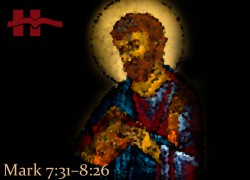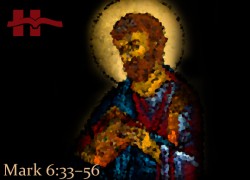Mark
Mark 8:27–9:13
The hope of future glory encourages disciples amidst present suffering while following Jesus.
“If anyone wishes to follow behind Me,
let him deny himself and take up his cross and follow Me!”
Mark 8:34
Allusions to who Jesus is have permeated the Gospel all along thus far; the crowds have often been amazed at Jesus’ words and deeds, and they have congregated in large numbers before him, but everyone—crowds and disciples—have failed to (fully) grasp the person
Mark 7:31–8:26
God can be trusted for the provision of life’s daily needs.
“Do you still not see or understand?”
Mark 8:17
This text demonstrates the continued lack of discernment on the part of Jesus’ disciples, which had been a constant theme in Act I of Mark (1:1–8:26). This last depiction of the disciples’ obtuseness (8:1–21) is bracketed between two miracles of perception: a deaf and dumb man is healed on one side (7:31–37), and the sight of a blind man is restored
Mark 7:1–30
Faith that produces obedience, not hypocritical allegiance to manmade rules, renders the disciple morally acceptable to God.
“The things which come out of one are the things that defile one.”
Mark 7:15
This pericope primarily deals with an issue of the “heart” (7:6, 19, 21): both purity and impurity begin “inside” (7:21, 23), not “outside” (7:15, 18). Jesus’ concern here is with moral purity—obedience to God’s commands. On the other hand, the Pharisees’
Mark 6:32–56
Disciples commissioned by the divinely powerful Jesus are themselves divinely empowered by him to meet any need.
“You yourselves give them to eat!”
Mark 6:37
The crowds gathered are like “sheep not having a shepherd” (6:34), a proverbial metaphor in the OT, used of Israel in a leadership vacuum (Num 27:17; 1 Kgs 22:17; Ezek 34:5–6). This sets the stage for the leadership role disciples are directed by Jesus to play. But they have apparently given no thought to
Mark 6:7–32
Disciples’ commission from Jesus, that attracts the world’s opposition, is enabled by God’s provision.
And He [Jesus] said to them [his disciples],
“Come away by yourselves to a secluded place and rest a while.”
Mark 6:31
This pericope is another Markan “sandwich” (outer story: 6:7–13 and 6:30–32; inner story: 6:14–29).
Jesus and John are strikingly similar in description: both are reported as raised from the dead (6:14; and 16:6–7), both are “arrested”
Mark 5:21–6:6
Jesus’ care, and his power over disease and death, evokes disciples’ fearless, efficacious faith.
“Do not be afraid, only believe.”
Mark 5:36:41
Mark 5:21–24 and 5:35–43 form the two halves of an outer story, with 5:25–34 being the inner story. The stories create a single tapestry. Look at the similarities: both protagonists are in hopeless situations; both fall at Jesus’ feet; both come into physical contact with Jesus; both conditions are ritually impure
Mark 4:35–5:20
Disciples’ faith in Jesus’ person and power enables them to fearlessly face natural and supernatural calamities.
“Who then is this, that even the wind and the sea obey Him?”
Mark 4:41
When you look at it, the story of the stilling of the storm is impressive in more ways than one. Yes, the miracle is truly awesome, but tempestuous sea and stormy wind are rendered almost demonic by Mark. The censure of the wind is as if it were an animate being, not to mention the



















 Abe Kuruvilla is the Carl E. Bates Professor of Christian Preaching at The Southern Baptist Theological Seminary (Louisville, KY), and a dermatologist in private practice. His passion is to explore, explain, and exemplify preaching.
Abe Kuruvilla is the Carl E. Bates Professor of Christian Preaching at The Southern Baptist Theological Seminary (Louisville, KY), and a dermatologist in private practice. His passion is to explore, explain, and exemplify preaching.